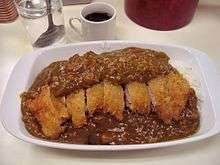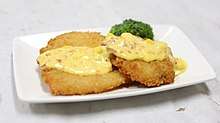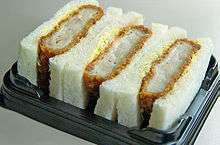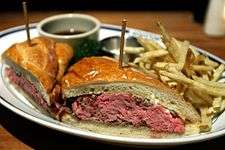Tonkatsu
 Tonkatsu | |
| Place of origin | Japan |
|---|---|
| Main ingredients | cutlet (pork fillet or loin), cabbage, miso soup |
Tonkatsu (豚カツ, とんかつ or トンカツ, [tonꜜkatsɯ]) pork cutlet, is a Japanese dish which consists of a breaded, deep-fried pork cutlet. The two main types are fillet and loin. It is often served with shredded cabbage. In Korea, tonkatsu is known as don-gaseu (돈가스) or don-kkaseu (돈까스), which derived from a transliteration of the Japanese word.
Etymology
The word tonkatsu is a combination of the Sino-Japanese word ton (豚) meaning "pig" and katsu (カツ), which is a shortened form of katsuretsu (カツレツ), the transliteration of the English word cutlet, which again derived from French côtelette, meaning "meat chop".
History
Japan
Tonkatsu originated in Japan in the 19th century. Early katsuretsu was usually beef; the pork version was invented in Japan in 1899 at a restaurant called Rengatei in Tokyo.[1][2][3] It was originally considered a type of yōshoku—Japanese versions of European cuisine invented in the late 19th and early 20th centuries—and was called katsuretsu or simply katsu.[4]
Korea
The dish was introduced to Korea around 1930s during the Japanese rule period, but the thick, Japanese-style tonkatsu failed to seize popularity.[5] Don-gaseu became popular in the 1960s, with the spread of gyeong-yangsik—light western food— restaurants.[6] The dish, although called by Japanese-derived name don-gaseu, followed western pork cutlet recipes such as those of Austrian Schnitzel - thinned by pounding before being breaded and deep-fried.[6] It was not sliced, and served with bread. Western-style appetizer soup was served before the dish. Don-gaseu developed into two distinct varieties. In 1977, gyeong-yangsik-style don-gaseu with thin meat became a popular menu in gisa-sikdang—drivers' restaurant, similar to transport café, for taxi drivers— with the addition of chili peppers and kimchi as an accompaniment.[7] As gyeong-yangsik restaurants nearly disappeared, this style of don-gaseu is now commonly served in drivers' restaurants and bunsik-jip (snack restaurants).[6] Second style of don-gaseu, with thicker meat and served sliced following the Japanese method, was made popular in 1983 by a restaurant called Myeongdong Dongaseu.[5] This style of don-gaseu is now commonly served in authentic Japanese restaurants.
Preparation and serving
Japan
Either a pork fillet (ヒレ hire) or pork loin (ロース rōsu) cut may be used; the meat is usually salted, peppered, dredged lightly in flour, dipped into beaten egg and then coated with panko (bread crumbs) before being deep fried.[8]
Tonkatsu is generally served with shredded cabbage.[9] It is most commonly eaten with a type of thick brown sauce called tonkatsu sauce or simply sōsu (sauce), karashi (mustard), and perhaps a slice of lemon. It is usually served with rice, miso soup and tsukemono and eaten with chopsticks. It may also be served with ponzu and grated daikon instead of tonkatsu sauce.
In addition to being served as a single dish, it is used as a sandwich filling or in combination with curry.
South Korea

Korean don-gaseu is different from Japanese tonkatsu in that it is thinner and often served unsliced, thus eaten with fork and knife, not chopsticks, and is served with demi-glace on top of the fried meat (or in case of fish cutlet, tartar sauce on the fried fish).[6] Common accompaniments include shredded cabbage sprinkled with ketchup-mayonnaise mixture, baked beans, macaroni salad, sweet corn, and danmuji (yellow pickled radish). Green chili peppers and doenjang (soybean paste) or ssamjang (wrap sauce) for dipping the chili peppers, baechu-kimchi (cabbage kimchi) or kkakdugi (radish kimchi), and rice with Korean or Japanese style soup can be served with the don-gaseu plate.[7] Alternatively, bread can replace rice, in which case Western-style soup is served before the main plate as an appetizer.[6]
Variations
Japan

Tonkatsu is also popular as a sandwich filling (katsu sando) or served on Japanese curry (katsu karē). Tonkatsu is sometimes served with egg on a big bowl of rice as katsudon.
In Nagoya and surrounding areas, miso katsu, tonkatsu eaten with a Hatchomiso-based sauce, is a specialty.[10]
Variations on tonkatsu may be made by sandwiching an ingredient such as cheese or shiso leaf between the meat, and then breading and frying. For the calorie conscious, konnyaku is sometimes sandwiched in the meat.
Several variations of tonkatsu use alternatives to pork:
- Chicken katsu (チキンカツ), which uses chicken instead, often appears in Hawaiian plate lunches.
- Menchi-katsu (メンチカツ) or Minchi Katsu (ミンチカツ mince Katsu), is a minced meat patty, breaded and deep fried.
- Hamu katsu (ハムカツ ham katsu), a similar dish made from ham, is usually considered a budget alternative to tonkatsu.
- Gyū katsu (牛カツ beef katsu), also known as bīfu katsu, is popular in the Kansai region around Osaka and Kobe.
A similar cuisine with ingredients other than pork, beef, or chicken is called furai (fry), not katsu (cutlet), such as aji-furai (fried horse mackerel) and ebi-furai (fried prawn).[11]
South Korea

- Saengseon-gaseu (생선가스), a fish cutlet similar to don-gaseu is served with tartar sauce, instead of demi-glace.
See also
References
- ↑ 岡田, 哲. とんかつの誕生―明治洋食事始め. p. 166.
- ↑ 小菅, 桂子. にっぽん洋食物語大全. p. 122.
- ↑ Kaneko, Amy (2007). Let's Cook Japanese Food!: Everyday Recipes for Home Cooking. Chronicle Books. p. 101. ISBN 0-8118-4832-9.
- ↑ Jennifer Ellen Robertson, ed. (2005). A companion to the anthropology of Japan. Wiley-Blackwell. p. 421. ISBN 0-631-22955-8.
- 1 2 박, 미향 (21 September 2016). "장사꾼의 끈기, '돈가스의 역사'를 쓰다". The Hankyoreh (in Korean). Retrieved 21 June 2017.
- 1 2 3 4 5 김, 철현 (3 October 2016). "한국식 돈까스는 왜 고추와 함께 먹을까?". The Asia Economy Daily (in Korean). Retrieved 21 June 2017.
- 1 2 박, 정배 (5 October 2015). "서양, 일본을 거친 오묘한 변주곡". Weekly Dong-A (in Korean) (1007). p. 76. Retrieved 21 June 2017.
- ↑ Tsuji, Shizuo; Fisher, M.F.K. (2007). Japanese Cooking: A Simple Art. Kodansha International. p. 240. ISBN 4-7700-3049-5.
- ↑ Hosking, Richard (1995). A Dictionary of Japanese Food - Ingredients and Culture. Tuttle. p. 159. ISBN 0-8048-2042-2.
- ↑ http://www.nic-nagoya.or.jp/en/e/archives/629
- ↑ "Katsu" (in Japanese). Dictionary of etymology.
Difference between katsu and furai is not defined explicitly; however, cuisine made of fish or vegetables are not called katsu but called furai.
External links
| Wikibooks Cookbook has a recipe/module on |
| Wikimedia Commons has media related to Tonkatsu. |


